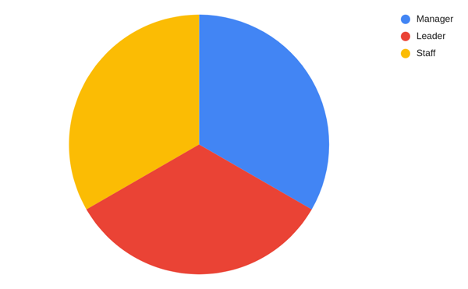By Hallmentum
Effective leaders know how to balance their time. Recognize how you divide your week or day so you can focus your leadership energy.
Do you ever find yourself short on time and over-stretched while doing too many things? We only have so much time in a given week. How you divide your time is up to you, but where should you provide focus?
There’s an old adage in project management: “Good, Fast, and Cheap: pick any two.” It’s a somewhat simplistic way to say “You can’t have it all.” A vendor can quickly (Fast) deliver a product that’s high quality (Good) but it will cost you. If you want it less expensive (Cheap) then you either have to sacrifice some quality or wait longer to have it delivered.
Leader, Manager, and Staff
I like to think along the lines of another triangle: Leader, Manager, or Staff. The “Leader, Manager, or Staff” concept helps us to understand the focus we need to put into our work. Because it really is about focus, a person really should concentrate on only two of the “legs” of this triangle: “Leader-Manager” “Leader-Staff,” or “Manager-Staff.” While it’s possible to do all three at once, doing so reduces focus in other areas.
For example, IT directors must provide leadership within their teams, but often do not have a login to the computer systems their teams manage. These are pure “Leaders.” They are focused almost entirely on the role of leadership.
Or consider this example: “working” managers typically provide day-to-day management over a small group or team, but also provide some hands-on assistance with technology systems. These individuals are “Manager-Staff” because they are dividing their time between two roles: manager and staff. These “working” managers may identify automation opportunities to make things easier, but rarely are they able to step back to see the big picture. Because part of their attention remains on daily tasks, they cannot focus on strategic changes that take their organization to the next level.
Larger organizations may see this example: an architect who designs new technology and provides leadership for how to leverage that technology. This kind of architect is “Leader-Staff” because their role is divided between a leadership focus and a hands-on technology focus. In most organizations, these architects do not manage a team of engineers; they usually work alone, or partnered with another architect, so they do not “manage.”
Focus your time
What kind of a leader are you? Do you focus most of your time on leadership, including strategic thinking and how to leverage technology as a power multiplier for your organization? Do you also manage members of a team? Do you fill a hands-on technology role? How you divide your time has a direct impact on what level of focus you can bring to your role.
Think of your week as a “pie” and divide your time into “slices” of the pie. You can’t make the pie any bigger unless you want to work through the weekend. How do you spend this available time? Start by considering the types of duties you perform each day:
Leader – Tracking trends, anticipating future needs, developing vision and strategies to achieve goals, engaging others.
Manager – Working to organize, allocate, and coordinate people or processes. Drafting goals and operational plans, allocating resources, budgets, assigning responsibilities.
Staff – The hands-on activities: collecting data for a report, providing help of a routine nature, developing basic business processes, and dealing with day-to-day email or phone calls.
We all do at least some of each category; for example, everyone needs to respond to emails and phone calls, which are necessary tasks, but are more grounded in the “Staff” category. But it’s the amount of time dedicated to emails and phone calls that matters; a well balanced leader will commit more time to strategic thinking, and much less time on hands-on work.
The pie is a model to help you find your focus. IT leaders such as CIOs and Directors will have a pie diagram that is mostly focused on leadership. Managers and supervisors will have a pie that has a very large “Manager” wedge. And systems administrators, network engineers, and other line staff will have pie diagrams that are mostly “Staff” activities.
Avoid trying to fit yourself equally across the entire pie. The “Renaissance Leader” is a myth; you cannot be successful in any one area if you try to do it all. Consider how “Leader” time diminishes as you try to add “Manager” and “Staff.” The pie of someone who was equally divided among all three areas would look like this:

[image: equally divided pie chart]
Providing an equal balance can lead to trouble because that implies someone who provides effective leadership, manages efficiently, and still does the day-to-day hands-on work. It’s really hard to do all of this work and do it well. A person who claims to be equally divided among all three often finds themselves too short on time, doing too many things, and not doing any of them well.
Provide a balance
As you move upwards in an organization, your focus changes, continually redefined. To succeed, you need to realize when to let go of your previous duties. The qualities and skills that helped put you in your current position may not be what moves you to the next level.
The path to successful leadership starts with balancing the “Leader/Manager/Staff” focus areas with the work that you do and your role in the organization. Consider how you need to spend your time, and what types of duties are important to the work that you do.
Do you need to provide vision or leadership for your area or organization? Try to exercise the most focus in “Leader” and find balance in “Manager” while limiting the “Staff.” Maybe your job function is to support a technology or service? Then you might focus on “Staff” while minimizing “Leader” and “Manager.” Some may give so much attention to one area that the other areas might be zero, and that’s okay too. How you divide your time may depend on where you are in the organization, and how you contribute.













